Stuffed Roast Chicken
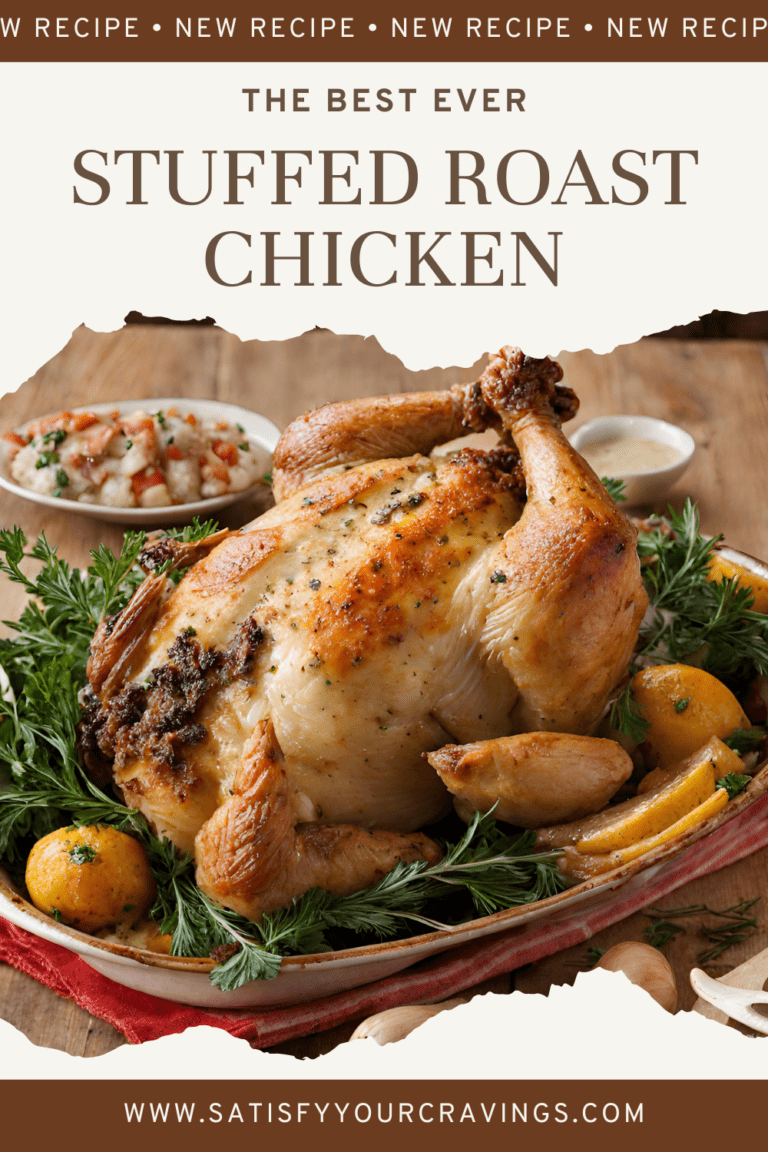
Perfect for Family Dinners and Special Occasions
There’s nothing quite like the comforting aroma of a Stuffed Roast Chicken wafting through your home. This recipe takes a classic dish to the next level with a flavorful stuffing made from fresh herbs, breadcrumbs, and vegetables that add depth and richness to every bite. Whether you’re preparing for a holiday feast, hosting a family dinner, or simply craving something hearty and delicious, this roasted chicken is the perfect centerpiece to impress your guests.
Not only is this Stuffed Roast Chicken golden and crispy on the outside, but it’s also tender, juicy, and bursting with flavor on the inside. Paired with sides like creamy mashed potatoes, roasted vegetables, and a drizzle of savory gravy, this dish is a complete meal that will leave everyone at the table satisfied. With simple ingredients and easy-to-follow steps, you can create a restaurant-worthy dish right in your own kitchen.
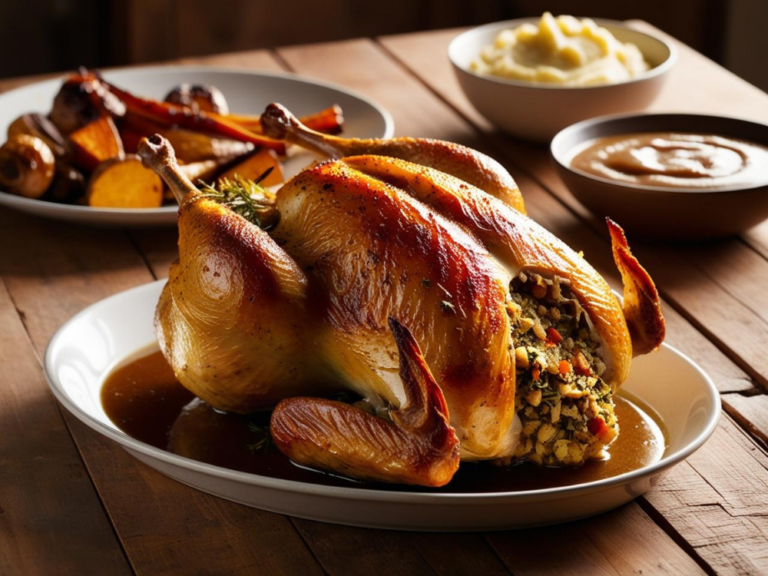
Why You’ll Love This Stuffed Roast Chicken Recipe
There’s something magical about the aroma of a Stuffed Roast Chicken roasting in the oven. It’s more than just a meal—it’s an experience that brings people together. Whether you’re hosting a holiday feast, a cozy family dinner, or simply treating yourself to a hearty, homemade meal, this recipe is a showstopper. The crispy, golden-brown skin gives way to juicy, flavorful meat, while the herb-packed stuffing adds a comforting depth of flavor that feels like a warm hug on a plate.
But the magic doesn’t stop there! This recipe is easy to follow and uses simple, everyday ingredients that you likely already have in your kitchen. It’s versatile too—you can customize the stuffing to suit your tastes or dietary preferences. Plus, the leftovers (if there are any!) make for incredible sandwiches, soups, or salads the next day. From the satisfying crunch of the perfectly roasted skin to the tender bite of herb-infused stuffing, every element of this dish is designed to delight. You’ll find yourself coming back to this recipe time and time again, not just for its taste, but for the warm memories it helps create around the dinner table.
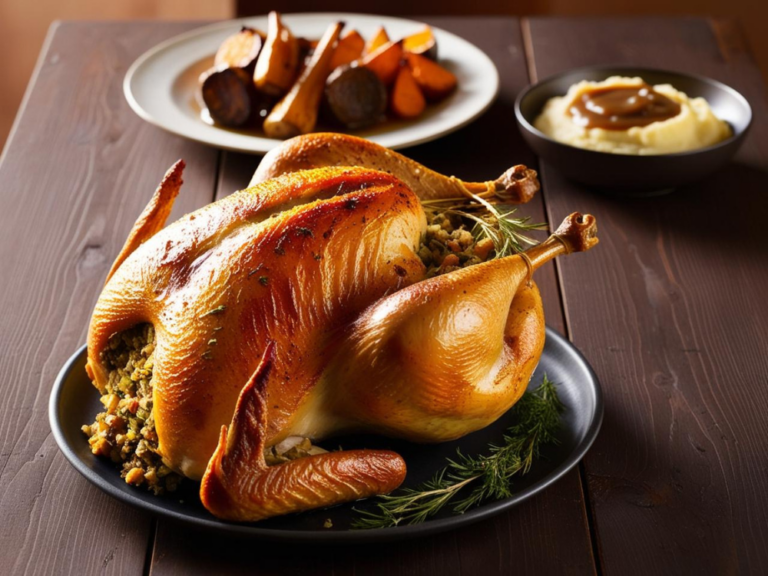
Side Dishes to Pair with Stuffed Roast Chicken
A perfectly roasted Stuffed Roast Chicken is a stunning centerpiece, but the sides you serve with it can take your meal to a whole new level. Whether you’re aiming for a comforting family dinner or an elegant holiday spread, the right accompaniments will round out the flavors, textures, and visual appeal of your table. Here’s a collection of side dish ideas that pair beautifully with the rich, savory flavors of stuffed roast chicken.
1. Creamy Mashed Potatoes
You can’t go wrong with the ultimate comfort food. Mashed potatoes are the perfect complement to stuffed roast chicken, soaking up all the flavorful juices and gravy. To elevate them, try adding roasted garlic, a dollop of sour cream, or even a touch of horseradish for a tangy kick.
2. Roasted Vegetables
A medley of roasted vegetables adds vibrant color and natural sweetness to your plate. Think carrots, parsnips, Brussels sprouts, or sweet potatoes. Toss them in olive oil, sprinkle with salt, pepper, and fresh herbs like rosemary or thyme, and let the oven work its magic alongside your chicken.
3. Buttery Dinner Rolls
Soft, fluffy dinner rolls are perfect for sopping up gravy or enjoying with a bit of butter. They also add a welcoming touch to the table. Bonus points if they’re homemade and fresh out of the oven!
4. Savory Stuffing Muffins
If you want to double down on the stuffing experience, try baking extra stuffing in muffin tins. This gives you perfectly portioned, crispy-on-the-outside, soft-on-the-inside bites that complement the stuffing inside the chicken.
5. Fresh Green Salad
For a lighter option, a crisp green salad is a refreshing contrast to the richness of the roast chicken. Toss mixed greens with a simple vinaigrette and add toppings like candied nuts, dried cranberries, or crumbled goat cheese to keep it interesting.
6. Glazed Carrots
Tender carrots with a honey or brown sugar glaze add just the right amount of sweetness to balance the savory flavors of the chicken and stuffing. A sprinkle of fresh parsley or dill on top adds a touch of freshness.
7. Homemade Gravy
No roast chicken is complete without a rich, savory gravy. Use the drippings from the chicken to make a flavorful, silky gravy that ties all the elements of your meal together. Pour it generously over the chicken, potatoes, and even vegetables for a truly indulgent experience.
8. Herbed Rice Pilaf
For something a little different, try serving herbed rice pilaf. The fluffy, fragrant rice infused with herbs like parsley or dill is a lighter alternative to potatoes but equally satisfying. You can even toss in some toasted almonds or dried fruit for added texture and flavor.
9. Cranberry Sauce
While typically reserved for turkey, cranberry sauce can be a surprisingly delightful pairing with roast chicken. Its tangy sweetness cuts through the richness of the dish and adds a festive flair to your table.
10. Sautéed Greens
Spinach, kale, or Swiss chard sautéed with garlic and a splash of lemon juice make a nutrient-packed, slightly bitter side that balances the richness of the chicken and stuffing.
11. Cheesy Scalloped Potatoes
For an indulgent option, cheesy scalloped potatoes layered with cream and melted cheese are always a hit. Their creamy texture and golden crust pair beautifully with the crispy skin of the roast chicken.
12. Cornbread or Corn Casserole
Add a touch of Southern charm with cornbread or a sweet-savory corn casserole. The mild sweetness of corn is a natural complement to the savory stuffing and chicken.
13. Roasted Garlic Broccoli
Broccoli, when roasted to slightly crisp edges, becomes a deliciously simple and healthy side. Add roasted garlic or a sprinkle of Parmesan cheese for an extra flavor boost.
14. Baked Mac and Cheese
For a crowd-pleaser, serve a rich, cheesy baked mac and cheese. It’s the ultimate comfort food side that kids and adults alike will love alongside roast chicken.
15. Pickled Vegetables or Chutney
Add a bright, tangy element to the table with pickled vegetables or a fruit chutney. These sides can cut through the richness of the roast chicken and add a unique flavor twist.
Pairing your Stuffed Roast Chicken with any combination of these side dishes will create a meal that’s well-rounded, flavorful, and unforgettable. Whether you’re keeping it simple or going all-out for a holiday spread, these options ensure that every bite is as enjoyable as the last. Let me know which sides you’ll try first or if you have any favorite pairings of your own!
Try some of our other recipes!
Stuffing Variations for the Perfect Roast Chicken
The stuffing is where you can let your creativity shine when making a Stuffed Roast Chicken. While the classic herb and breadcrumb stuffing is always a winner, there are countless ways to customize it to suit your taste, the season, or the occasion. Whether you prefer savory, sweet, or something with a bold twist, these stuffing variations will take your roast chicken to the next level.
1. Classic Herb and Bread Stuffing
Let’s start with the tried-and-true classic. A blend of day-old bread cubes, onions, celery, and fresh herbs like parsley, thyme, and sage creates a savory and aromatic stuffing that pairs perfectly with roast chicken. Add chicken broth to keep it moist and butter for a rich, comforting flavor.
2. Sausage and Apple Stuffing
For a heartier option, try incorporating crumbled sausage into your stuffing. The sausage adds a savory, slightly smoky flavor, while diced apples bring a touch of sweetness and balance. Add a handful of dried cranberries or raisins for a festive twist.
3. Wild Rice and Mushroom Stuffing
Looking for a gluten-free option? Wild rice is a fantastic base for stuffing. Combine it with sautéed mushrooms, onions, and garlic for an earthy, hearty stuffing. Toss in some chopped nuts like pecans or almonds for a bit of crunch and texture.
4. Cornbread Stuffing
Cornbread brings a unique, slightly sweet flavor to your stuffing. Mix crumbled cornbread with diced onions, celery, and fresh sage. For a Southern-inspired touch, add a little cooked bacon or a dash of hot sauce to spice things up.
5. Mediterranean Stuffing
Give your stuffing a Mediterranean flair by using couscous or bulgur as the base. Add ingredients like sun-dried tomatoes, Kalamata olives, crumbled feta cheese, and fresh parsley. A squeeze of lemon juice ties it all together for a bright, zesty flavor.
6. Fruit and Nut Stuffing
For a sweet-savory combination, try a stuffing with dried fruits like apricots, figs, or cherries. Pair them with chopped nuts such as walnuts, pecans, or pistachios. The contrast of textures and flavors adds a gourmet touch to your roast chicken.
7. Vegetarian-Friendly Stuffing
Skip the meat and focus on bold flavors with a vegetarian stuffing. Use a mix of quinoa, roasted vegetables, and fresh herbs. Add a touch of grated Parmesan or nutritional yeast for a hint of umami, and toss in a splash of vegetable stock to keep it moist.
8. Cranberry and Chestnut Stuffing
Perfect for the holidays, this stuffing combines tart cranberries with rich, nutty chestnuts. Add fresh rosemary and a pinch of nutmeg to bring out the festive flavors. This stuffing pairs beautifully with the juicy, golden chicken.
9. Cheesy Stuffing
For cheese lovers, consider mixing shredded cheese like cheddar, Gruyère, or Parmesan into your stuffing. A cheesy stuffing works especially well with breadcrumbs or rice as a base. Just be sure not to overload the cheese—it should enhance the flavor, not overpower it.
10. Spicy Chorizo Stuffing
Kick things up a notch with spicy chorizo. Combine cooked chorizo with bread cubes, onions, bell peppers, and a sprinkle of smoked paprika for a bold, flavorful stuffing. This variation adds a vibrant kick that pairs wonderfully with the rich roast chicken.
11. Herb and Lemon Stuffing
Keep it light and fresh with a stuffing packed with fresh herbs like parsley, dill, and tarragon, along with zesty lemon juice and zest. This variation is perfect for spring or summer dinners and complements the natural flavors of the chicken.
12. Pesto and Parmesan Stuffing
Bring a touch of Italian flair to your roast chicken by mixing pesto with breadcrumbs and grated Parmesan cheese. The bright, garlicky flavor of pesto pairs beautifully with the juicy chicken and creates a stuffing that’s both simple and delicious.
13. Maple Bacon Stuffing
For a decadent twist, combine crispy bacon with a drizzle of maple syrup, breadcrumbs, and caramelized onions. This stuffing is smoky, sweet, and utterly irresistible, perfect for special occasions or when you want to impress.
14. Vegetable and Herb Medley Stuffing
For a healthier option, focus on fresh vegetables like zucchini, carrots, and bell peppers. Dice them finely and sauté with garlic and herbs, then mix with quinoa or couscous. It’s a light yet flavorful stuffing that pairs beautifully with the chicken.
15. Southwestern Stuffing
Add a Tex-Mex twist to your roast chicken with a stuffing made from cornbread, black beans, corn, diced green chiles, and a sprinkle of cumin and chili powder. A handful of shredded cheese and fresh cilantro ties it all together.
With so many options to choose from, you can tailor your Stuffed Roast Chicken to any occasion or personal preference. Don’t be afraid to experiment with different combinations of ingredients to create a stuffing that’s uniquely yours. Whether you stick with a comforting classic or try something bold and unexpected, the stuffing is your chance to add a personal touch to this timeless dish. Let us know which variation you’ll try first—or better yet, share your own stuffing ideas!
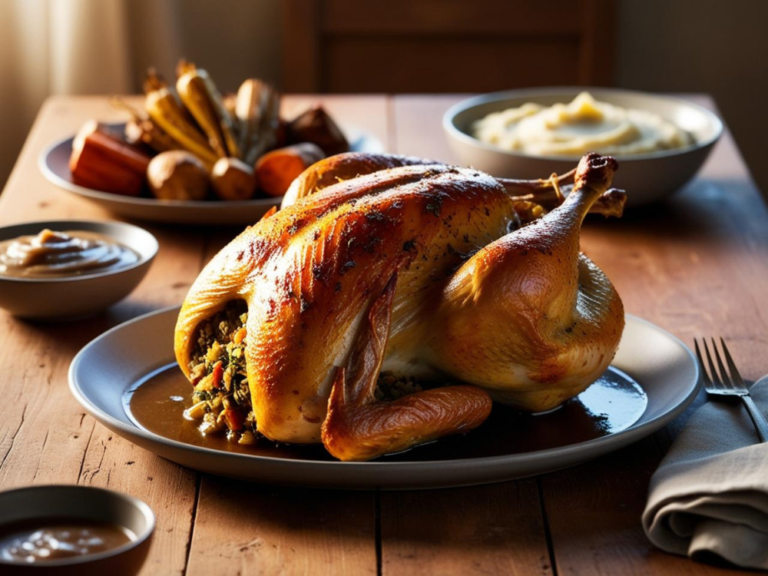
How to Make Gravy from Drippings: The Perfect Finishing Touch
No roast chicken dinner is complete without a rich, velvety gravy to tie everything together. The beauty of making gravy from drippings is that it captures the essence of your Stuffed Roast Chicken—the savory flavors of the roasted chicken, the aromatic herbs, and the caramelized goodness that develops in the roasting pan. It’s the ultimate comfort food topping, and best of all, it’s surprisingly simple to make. Here’s everything you need to know to create the perfect gravy, step by step.
1. Gather Your Drippings
Once your stuffed roast chicken is done roasting, don’t toss the pan juices—they’re liquid gold! Carefully pour the drippings from the roasting pan into a heatproof measuring cup or bowl. If you notice a lot of fat separating from the liquid, don’t worry—you’ll skim that off in the next step.
2. Separate the Fat
Allow the drippings to sit for a few minutes so the fat rises to the top. Use a spoon or a fat separator to skim off most of the fat, leaving behind the flavorful juices. You’ll want a little fat left, as it adds richness to your gravy.
3. Deglaze the Roasting Pan
Before cleaning your roasting pan, place it over medium heat on the stovetop and pour in a cup of liquid—this can be chicken stock, white wine, or even water. Use a wooden spoon to scrape up the browned bits stuck to the bottom of the pan (known as “fond”). This step unlocks incredible depth of flavor for your gravy.
4. Create a Roux
In a separate saucepan, melt 2–3 tablespoons of butter over medium heat. Once melted, whisk in an equal amount of all-purpose flour. Stir constantly for about 2 minutes, until the mixture turns golden and develops a nutty aroma. This roux will be the base that thickens your gravy.
5. Add the Drippings
Slowly pour the reserved drippings into the saucepan with the roux, whisking constantly to prevent lumps. Once combined, gradually add an additional 1–2 cups of chicken stock, depending on how much gravy you want to make and how thick you like it. Keep whisking until the mixture is smooth.
6. Simmer and Season
Bring the gravy to a gentle simmer and cook for about 5–7 minutes, allowing it to thicken. Stir frequently to ensure it doesn’t stick to the bottom of the pan. Taste your gravy and season as needed with salt, freshly ground black pepper, and any additional herbs or spices. A splash of heavy cream can also be added for extra richness.
7. Optional Enhancements
To elevate your gravy even further, consider adding:
- A splash of dry sherry or white wine for a touch of acidity.
- A teaspoon of Worcestershire sauce for a deeper umami flavor.
- Fresh herbs like thyme or parsley for brightness.
- A pinch of garlic powder or onion powder for added depth.
8. Strain for Smoothness
For an ultra-smooth gravy, pour it through a fine-mesh sieve into a serving dish or gravy boat. This step removes any lumps or bits of herbs, ensuring a silky texture that glides over your chicken and sides.
9. Serve Immediately
Gravy is best enjoyed fresh and warm. Serve it alongside your stuffed roast chicken, mashed potatoes, and any other sides. Pour it generously over your plate, letting it seep into every bite for the ultimate comfort food experience.
Troubleshooting Tips
If your gravy isn’t perfect on the first try, here are some common fixes:
- Too thin? Simmer longer to reduce the liquid or whisk in a cornstarch slurry (1 tablespoon cornstarch mixed with 2 tablespoons cold water).
- Too thick? Add a splash of chicken stock or water to thin it out.
- Too bland? Adjust with more salt, pepper, or a flavor booster like Worcestershire sauce.
Why Homemade Gravy is Worth It
Making gravy from drippings adds an unparalleled depth of flavor to your meal. It’s not just a topping; it’s the element that brings everything together, turning your roasted chicken and sides into a cohesive, restaurant-quality dish. Plus, you’re making use of ingredients you already have, minimizing waste and maximizing flavor.
With this foolproof method, you’ll have a gravy that’s rich, flavorful, and worthy of your Stuffed Roast Chicken masterpiece. Once you taste it, you’ll never settle for store-bought again! Let me know how your gravy turns out—or if you have any secret ingredients you love adding to yours.
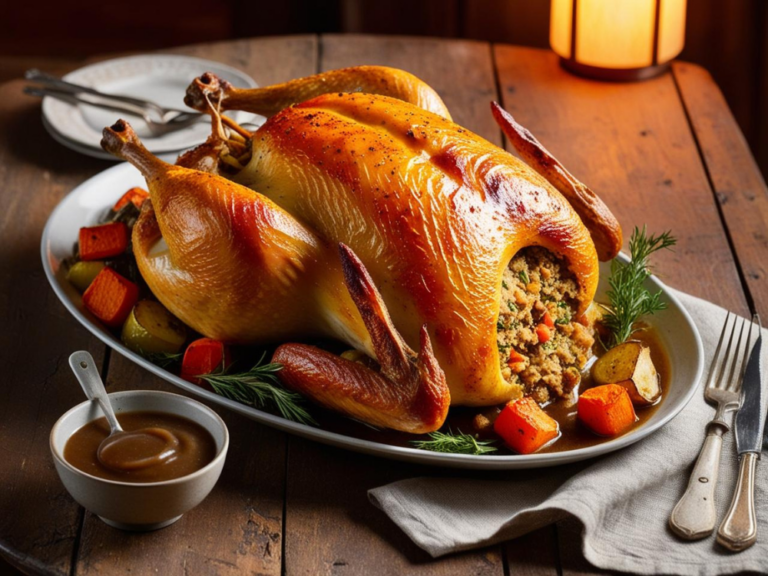
Cooking Times by Weight: Perfectly Roasting Your Stuffed Chicken Every Time
Getting your Stuffed Roast Chicken to come out perfectly cooked, juicy, and delicious isn’t just about the recipe—it’s also about timing. The cooking time for roast chicken largely depends on its weight, especially when it’s stuffed. Overcooking can lead to dry, tough meat, while undercooking is a food safety risk. To ensure your chicken is roasted to perfection, it’s crucial to follow the correct cooking times based on weight and check the internal temperature to confirm it’s done.
General Rule for Cooking Stuffed Chicken
When roasting a stuffed chicken, the general guideline is to cook it at 350°F (175°C) for 18–20 minutes per pound. This time includes the added mass of the stuffing, which needs to reach a safe internal temperature of 165°F (74°C) to ensure it’s fully cooked and safe to eat.
Cooking Time Chart by Weight
Here’s a handy guide to help you determine how long to roast your stuffed chicken:
| Weight of Chicken | Cooking Time (at 350°F) |
|---|---|
| 3 lbs (1.4 kg) | 1 hour 15 minutes to 1 hour 30 minutes |
| 4 lbs (1.8 kg) | 1 hour 30 minutes to 1 hour 40 minutes |
| 5 lbs (2.3 kg) | 1 hour 50 minutes to 2 hours |
| 6 lbs (2.7 kg) | 2 hours 10 minutes to 2 hours 20 minutes |
| 7 lbs (3.2 kg) | 2 hours 30 minutes to 2 hours 40 minutes |
| 8 lbs (3.6 kg) | 2 hours 50 minutes to 3 hours |
| 9 lbs (4.1 kg) | 3 hours 10 minutes to 3 hours 20 minutes |
How to Check If It’s Done
While these cooking times are a great starting point, the only way to be sure your stuffed roast chicken is fully cooked is by checking the internal temperature with a meat thermometer. Here’s what to look for:
- Chicken Meat: The thickest part of the chicken (usually the breast or thigh) should reach an internal temperature of 165°F (74°C).
- Stuffing: The center of the stuffing should also be at least 165°F (74°C) to ensure any juices from the chicken that seeped into it during cooking are safely cooked.
Tips for Perfect Timing
Let the Chicken Come to Room Temperature: Before roasting, allow your chicken to sit at room temperature for 30 minutes. This helps it cook more evenly and reduces overall cooking time.
Preheat the Oven: Always preheat your oven to ensure consistent cooking. Starting with a cold oven can throw off cooking times and lead to uneven results.
Cover with Foil if Needed: If the skin is browning too quickly, tent the chicken with aluminum foil for the remainder of the cooking time. This prevents burning while allowing the chicken to cook through.
Allow for Resting Time: After removing the chicken from the oven, let it rest for 15–20 minutes. This allows the juices to redistribute, keeping the meat moist and flavorful.
Adjusting for Higher or Lower Temperatures
If you’re cooking at a different temperature, adjust the timing accordingly:
- 325°F (163°C): Add about 5 minutes per pound to the cooking time.
- 375°F (190°C): Reduce the cooking time by about 5 minutes per pound.
- 400°F (204°C): Reduce the cooking time by 8–10 minutes per pound but check frequently to avoid overcooking.
What Happens If Your Chicken Is Overstuffed?
An overstuffed chicken can significantly increase cooking time because the heat needs to penetrate the thick center of the stuffing. To avoid this, stuff the chicken loosely, allowing air to circulate within the cavity. If you have extra stuffing, bake it separately in a dish.
Why Cooking Time Matters
Roasting your chicken for the right amount of time ensures it’s not only safe to eat but also juicy, tender, and bursting with flavor. Cooking it too long can dry out the meat, while undercooking can result in raw stuffing or unsafe meat. Following these guidelines and checking the internal temperature gives you peace of mind and a delicious result every time.
Pro Tip: Use a Dual Probe Thermometer
For the best results, invest in a dual probe thermometer. Place one probe in the thickest part of the chicken and the other in the center of the stuffing. This way, you can monitor both temperatures without opening the oven frequently, which helps maintain consistent heat.
Final Thoughts
Cooking your Stuffed Roast Chicken to perfection doesn’t have to be intimidating. By using these cooking times as a guide and relying on your meat thermometer to confirm doneness, you’ll achieve a beautifully roasted chicken with moist meat and a deliciously cooked stuffing every time. Let me know how your roast turns out or if you have any additional tips to share!

Frequently Asked Questions About Stuffed Roast Chicken
When it comes to cooking a Stuffed Roast Chicken, you might have some questions. Whether you’re making it for the first time or looking to perfect your technique, having the right information can make all the difference. Below are answers to some of the most common FAQs to help you create a perfectly roasted, juicy, and flavorful chicken every time.
1. How Do I Know When My Stuffed Roast Chicken Is Fully Cooked?
The best way to ensure your chicken is fully cooked is by using a meat thermometer. Check the temperature in two places:
- Thickest part of the chicken (breast or thigh): It should read at least 165°F (74°C).
- Center of the stuffing: It should also reach 165°F (74°C) to ensure it’s safe to eat.
Avoid relying solely on color or juices running clear, as these aren’t always accurate indicators of doneness.
2. Can I Make the Stuffing Ahead of Time?
Yes, you can prepare the stuffing ahead of time, but it’s important to handle it properly to ensure food safety:
- Keep the stuffing refrigerated until you’re ready to stuff the chicken.
- If the stuffing has been in the fridge, allow it to come to room temperature before adding it to the chicken to ensure even cooking.
- Alternatively, you can cook the stuffing separately in a baking dish, which is a safer option and allows the chicken to cook more evenly.
3. How Much Stuffing Should I Use?
It’s important not to overstuff the chicken. Fill the cavity loosely, allowing room for the stuffing to expand as it cooks. Overstuffing can increase cooking time and result in unevenly cooked chicken or stuffing. If you have extra stuffing, bake it in a separate dish.
4. What’s the Best Way to Keep the Chicken Moist?
Here are a few tips to keep your roast chicken juicy and flavorful:
- Brine the chicken before roasting to lock in moisture.
- Baste the chicken periodically with its own juices or melted butter during cooking.
- Let the chicken rest for 15–20 minutes after roasting to allow the juices to redistribute throughout the meat.
5. Can I Use a Frozen Chicken?
You can use a frozen chicken, but it must be fully thawed before roasting to ensure even cooking. Thaw it in the refrigerator for 24–48 hours, depending on the size of the chicken. Avoid thawing at room temperature, as this can lead to bacterial growth.
6. How Do I Prevent the Skin from Burning?
If the skin starts to brown too quickly, tent the chicken with aluminum foil. This will protect the skin while allowing the chicken and stuffing to continue cooking. Remove the foil during the last 15–20 minutes to crisp up the skin.
7. How Long Should I Let the Chicken Rest After Cooking?
Let the chicken rest for 15–20 minutes after removing it from the oven. This resting period allows the juices to redistribute, ensuring moist and tender meat. Cover the chicken loosely with foil while it rests to keep it warm.
8. Can I Cook the Stuffing Separately?
Yes, and it’s a great option for those who want to ensure both the chicken and stuffing are cooked perfectly. Simply prepare the stuffing and bake it in a separate dish alongside the chicken. This method is also safer, as the stuffing doesn’t come into contact with raw chicken juices.
9. What Should I Do with Leftover Stuffed Roast Chicken?
Leftovers can be transformed into delicious meals! Here are a few ideas:
- Chicken Salad: Shred the meat and mix it with mayonnaise, celery, and herbs for a quick salad.
- Soup: Use the bones to make stock and add the meat to a hearty chicken soup.
- Sandwiches or Wraps: Slice the chicken and stuffing to create flavorful sandwiches.
- Casseroles: Incorporate leftovers into a chicken and stuffing bake with vegetables and gravy.
Store leftovers in an airtight container in the refrigerator for up to 3–4 days.
10. Can I Add Vegetables to the Roasting Pan?
Absolutely! Adding vegetables like carrots, potatoes, onions, and parsnips to the roasting pan creates a flavorful side dish that cooks alongside the chicken. Toss the vegetables in olive oil, season them with salt and pepper, and arrange them around the chicken.
11. Can I Make This Recipe Gluten-Free or Dairy-Free?
Yes! For a gluten-free version, use gluten-free bread or rice for the stuffing. For a dairy-free version, substitute butter with a plant-based alternative or olive oil. Always check your broth and other ingredients to ensure they meet your dietary needs.
12. What’s the Best Way to Reheat Stuffed Roast Chicken?
Reheating stuffed chicken can be tricky, as you want to avoid drying it out. Here’s how:
- Preheat your oven to 325°F (163°C).
- Wrap the chicken in aluminum foil to retain moisture.
- Heat for 15–20 minutes or until warmed through. For stuffing, reheat separately in a covered baking dish to ensure even heating.
13. How Can I Add More Flavor to the Chicken?
For extra flavor, try these techniques:
- Rub a mixture of butter, garlic, and herbs under the chicken’s skin before roasting.
- Stuff the cavity with aromatics like garlic cloves, lemon halves, and fresh herbs.
- Season generously with salt and pepper both inside and out.
14. Can I Roast the Chicken at a Higher Temperature?
You can roast the chicken at a higher temperature, such as 375°F (190°C) or 400°F (204°C), to speed up cooking or achieve crispier skin. Just be sure to monitor the internal temperature closely and adjust the cooking time accordingly.
15. What Are the Best Herbs for Stuffed Roast Chicken?
Classic herbs like sage, thyme, rosemary, and parsley work beautifully in both the stuffing and on the chicken. Experiment with different combinations to find your favorite flavor profile.
By answering these FAQs, you’re equipped with everything you need to create a foolproof Stuffed Roast Chicken. If you still have questions, feel free to drop a comment or share your favorite tips—let’s make this dish a guaranteed success for everyone!
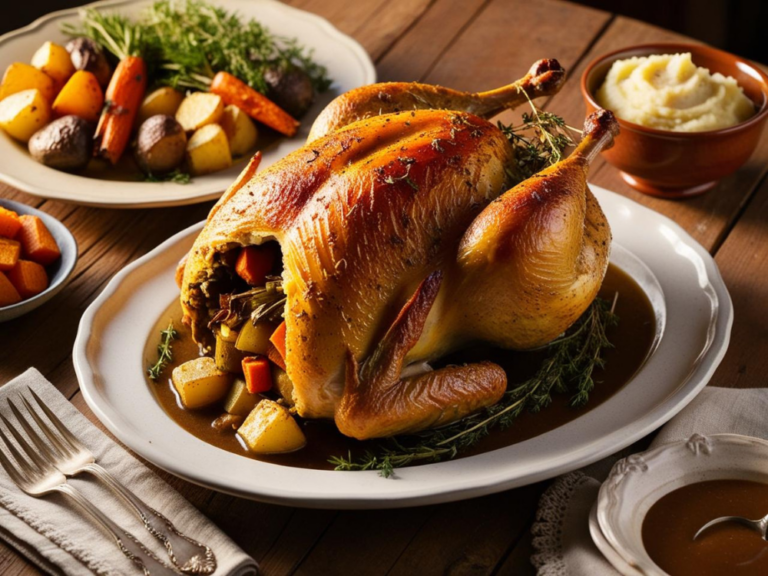
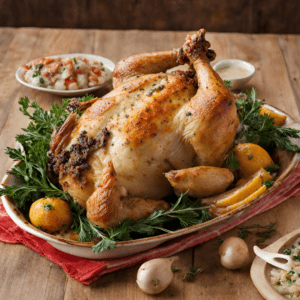
Stuffed Roast Chicken
Equipment
- Roasting Pan: A heavy-duty roasting pan with high sides is essential for even cooking and catching the delicious drippings for gravy.
- Meat Thermometer: Ensure your chicken and stuffing are perfectly cooked and safe to eat by checking that the internal temperature reaches 165°F (74°C).
- Mixing Bowls: Use these to prepare and combine the stuffing ingredients and any seasoning blends.
- Basting Brush: Ideal for brushing melted butter or pan juices over the chicken to keep it moist and enhance browning.
- Sharp Knife and Cutting Board: For chopping vegetables, herbs, and other ingredients for the stuffing.
- Kitchen Twine: Use this to truss the chicken, ensuring even cooking and preventing the stuffing from spilling out.
- Aluminum Foil: Helps tent the chicken if the skin starts browning too quickly and keeps it warm during the resting period.
- Fat Separator (Optional): Makes it easy to separate fat from the drippings when making gravy, resulting in a smooth, flavorful sauce.
- Whisk: Essential for creating a smooth roux and lump-free gravy.
- Oven Mitts or Gloves: Protect your hands when handling the hot roasting pan or removing the chicken from the oven.
Ingredients
- 1 Whole chicken (about 4-5 pounds)
- 2 Cups Bread cubes for stuffing
- 1 Cup Chicken broth (plus more if needed)
- 1 Large onion, chopped
- 3 Cloves of garlic, minced
- 1/2 Cup Diced celery
- 1/2 Cup Diced carrots
- 2 Tsbp Fresh thyme, chopped
- 2 Tsbp Fresh rosemary, chopped
- 1/2 Cup Unsalted butter, melted
- Salt and pepper to taste
- Optional: slices of lemon, apple slices, or herbs for additional flavor
Instructions
- Preparation: Preheat your oven to 375°F. Begin with a clean workspace and a thawed chicken. Remove the innards, rinse the chicken inside and out, and pat it dry with paper towels.
- Making the Stuffing: In a large bowl, mix the bread cubes, onions, garlic, celery, carrots, thyme, and rosemary. Pour in the melted butter and chicken broth gradually until the mixture is moist but not soggy. Season with salt and pepper to taste.
- Stuffing the Chicken: Season the cavity of the chicken with salt and pepper. Fill it with the stuffing mixture, but don't overpack. Excess stuffing can be cooked separately in a baking dish.
- Truss and Season: Truss the chicken legs and tuck the wing tips under the body. This isn't just for looks; it helps the chicken cook evenly. Rub the outside with butter, salt, and pepper.
- Roasting: Place the chicken breast-side up in a roasting pan. Roast for about 20 minutes per pound, or until the internal temperature reaches 165°F. Baste occasionally with pan juices.
- Resting: Let the chicken rest for 10-15 minutes before carving. This ensures the juices redistribute for moist, tender meat.
Notes
Make-Ahead Tips
-
Prepare the Stuffing in Advance
- You can make the stuffing up to 2 days ahead and store it in an airtight container in the refrigerator. Bring it to room temperature before stuffing the chicken to ensure even cooking.
- Alternatively, bake the stuffing separately in a casserole dish on the day of serving.
-
Season the Chicken Ahead of Time
- Season the chicken with your preferred herbs, spices, and a generous amount of salt the night before. Store it uncovered in the refrigerator to allow the skin to dry out slightly for crispier results during roasting.
-
Fully Prep the Chicken
- If you want to save time on the day of cooking, you can clean, season, and stuff the chicken up to 24 hours in advance. Keep it covered in the refrigerator until you’re ready to roast.
-
Pre-Cook Side Dishes
- Save time by preparing side dishes like mashed potatoes or roasted vegetables in advance. Reheat them just before serving to keep your focus on the chicken.
Storing Leftovers
-
Refrigerating Leftovers
- Let the chicken cool to room temperature before storing. Remove any leftover stuffing from the cavity and store it separately.
- Place the chicken and stuffing in airtight containers and refrigerate within 2 hours of cooking.
- Leftovers will keep in the refrigerator for up to 3–4 days.
-
Freezing Leftovers
- For longer storage, freeze cooked chicken and stuffing in airtight containers or heavy-duty freezer bags.
- Label with the date and freeze for up to 3 months.
-
Reheating Leftovers
- To reheat chicken, preheat your oven to 325°F (163°C). Wrap the chicken in aluminum foil to retain moisture and heat for 15–20 minutes or until warmed through.
- For stuffing, reheat in a baking dish, covered with foil, to prevent it from drying out.
-
Using Leftovers Creatively
- Transform leftover chicken into soups, salads, casseroles, or sandwiches. The stuffing can also be repurposed as a side for other meals or mixed into omelets for a hearty breakfast.
Planning ahead and properly storing leftovers ensures your Stuffed Roast Chicken stays fresh and delicious, whether you’re preparing for a big meal or enjoying the flavors later. Let us know if you need more tips!

A Wholesome Ending to a Delicious Meal
There’s something truly special about sharing a meal like Stuffed Roast Chicken with the people you care about. It’s more than just food—it’s a tradition, a celebration, and a way to bring everyone together around the table. From the crispy, golden skin to the savory, flavorful stuffing, this dish is the perfect combination of comfort and elegance.
Whether you’re preparing it for a holiday feast, a family dinner, or just because, this recipe has everything you need to create a memorable meal. The aromas will fill your home with warmth, and the flavors will leave everyone satisfied and asking for seconds. So go ahead, pour some gravy, pass the sides, and enjoy the moments that come with serving a dish made with love.
I hope this recipe becomes a cherished favorite in your kitchen. Don’t forget to share your experience—whether it’s a tweak you made to the stuffing, a creative side dish pairing, or a memory you created while making it. Let’s keep the tradition alive, one delicious roast chicken at a time.
Join Now!
Love this recipe? Don’t miss out on even more delicious, healthy, and easy-to-make recipes like this Stuffed Roast Chicken! By joining our email community, you’ll gain access to exclusive content, bonus recipes, and tips to make clean eating a breeze.
Enter your email & click below to subscribe and start receiving tasty inspiration right away. It only takes a minute to join our growing community of food lovers dedicated to making healthy eating delicious and fun.
